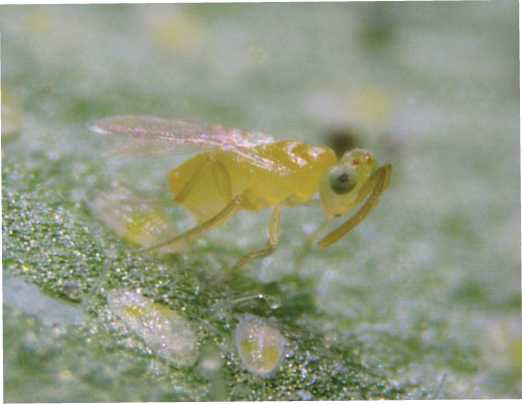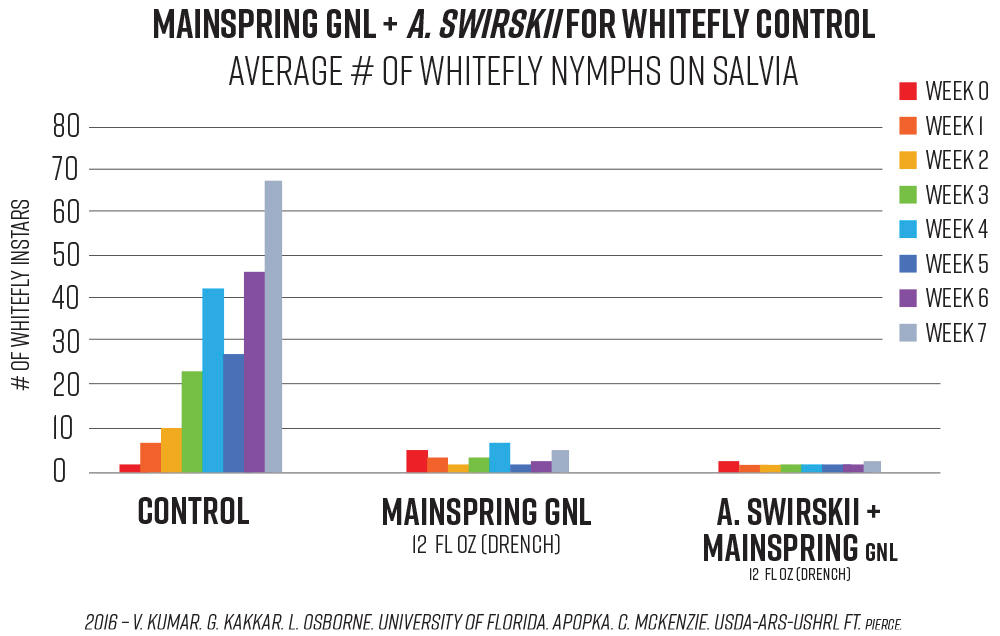
Biological control agents — beneficial living organisms or microorganisms that feed on other insects that attack plants, helping to lessen the pest population — have increased in popularity in recent years. Research has shown that more growers have made them a critical part of their integrated pest management (IPM) programs.
Whether insect-based or comprised of bacteria, fungi or viruses, biocontrols provide a preventive pest control solution while offering many environmental benefits. They protect crops while naturally eliminating the insect population before it spreads diseases like leaf wilt, root rot or crown gall disease.
“Biocontrols only feed on the bad insects we want to get rid of. These organisms control the insects and pathogens that attack the plants, so they are our friends,” says Dr. Luis Canas, associate professor of insect ecology in controlled environments and director of the College of Food, Agricultural, and Environmental Sciences International Programs at The Ohio State University.
“Used alongside insecticides, biologicals can help create an effective, versatile IPM [program] for growers. However, it’s important to plan ahead and incorporate them appropriately to obtain the best results,” adds Canas, whose expertise includes insect management using insecticides and biological control agents to solve problems caused by thrips, whiteflies and mites, among others.
LOOK TO THE PAST TO PREPARE FOR THE FUTURE
“Biologicals work most efficiently when applied very early in the growing season when pest numbers are low. Introducing them when you already have significant insect problems will yield disappointing results,” notes Canas.
“Biocontrols are best used as a prevention tool before you see pests, because you want to prevent the problem from happening by preparing an insecticide rotation plan based on two criteria: mode of action and compatibility with these biocontrol agents,” explains Canas.
Growers should do their homework by preparing an IPM plan for the facility in advance based on learnings from the previous season.
“For example, if you had problems with aphids last year, there’s a good chance you may have aphids again, so before there’s an increase in the population of bad insects, you release the good ones, so they fight for you to keep those plants clean, like little soldiers,” says Canas.
Be sure you’ve correctly identified the pests found on your crops, as this is a vital step that many growers might skip.
“Verifying the identity of the pest is very important, because if you think you have one species of pest, but it’s something else, what you’re purchasing may not work,” he explains.
Consult with extension educators or pest control suppliers for pest verification.

PLENTY OF OPTIONS TO CHOOSE FROM
With many popular biocontrols on the market, it’s easy for growers to be overwhelmed. Decide what to buy and where, based on which crops you’re growing and the pests you want to target.
“For certain insects, there are two recommended types of specific biocontrol agents: predators or parasitoids, which are larger insects that are good for mites, and very small ones called biopesticides, which are fungi or viruses that will only attack the pests, not the plants,” notes Canas.
To control thrips that attack ornamentals and vegetables, one of the most common biocontrol species is the predatory mite, Amblyseius swirskii.
“These species have been on the market for a while, but as more people have become interested in this option, the prices have gone down, and availability has increased,” says Canas. “To thwart aphids, Aphidius colemani is effective. For whiteflies, try the insidious flower bug or Encarsia formosa.”
INTRODUCE BIOCONTROLS SLOWLY
Once growers determine their needs, it’s time to figure out how to release biocontrols into their insecticide rotation so they’re compatible with facility logistics.
“If this is your first year using biocontrol agents, start it on a smaller zone so you can learn how the shipments arrive and how they work,” suggests Canas. “These are living organisms, so if they’re sent via a postal service and the delivery person puts the box in front of your facility under a lot of sun, the organisms will get killed inadvertently.”
It is also important to train your staff so they know how to release the biocontrols. “For example, if you irrigate with a boom system, you’ll wash them away. But if you position the cards or the release cages with their opening pointing down, that will help.
“When applying an insecticide and a beneficial organism, you don’t want to spray at the same time you’re releasing a beneficial,” explains Canas. “Sometimes that happens when there’s not enough communication to prevent that, so speak to suppliers; they’re the experts who can guide you through the process.”

CHOOSE INSECTICIDES THAT ARE COMPATIBLE WITH BIOLOGICALS
When adding biological control agents into their IPM programs, growers must consider which insecticides to apply to prevent and fight off pest populations. Select products that pair with biologicals to ensure a successful IPM program. Syngenta offers several insecticides that work well in an integrated program with biocontrols, including Endeavor®, Mainspring® GNL and Acelepryn® insecticides.
“Endeavor in IRAC group 9B provides focused control of aphids and whiteflies, so it can be combined with many parasitoids and predatory mites,” explains Nancy Rechcigl, technical field manager for ornamentals at Syngenta. “After initial ingestion, the insect quickly stops feeding and eventually dies.
“As a spray, Endeavor provides 14 to 21 days of control, while as a drench it provides seven weeks of control. It can be helpful to clean up an aphid outbreak that gets out of control, and then parasitoids such as Aphidius colemanii or A. ervi can be released back into the crop,” Rechcigl adds.
“Mainspring GNL in IRAC group 28 also stops insects from feeding, limiting injury and establishment using a different mechanism,” Rechcigl continues. “It causes calcium ions to be released from the insect muscles, which interferes with and stops feeding.”
A powerful tool that protects ornamental crops from chewing and sucking pests, including whiteflies, aphids, leafminers and lacebugs, Mainspring GNL is a broad-spectrum, non-neonicotinoid insecticide with cyantraniliprole as its active ingredient. Because it quickly paralyzes insects to stop feeding, this product limits disease transmission and damage to foliage and flowers. Its four-hour restricted-entry interval (REI) and no need for special personal protective equipment make this product convenient for growers to use alongside biocontrols.Mainspring GNL has broad activity across pests such as aphids, leafminers, thrips and whiteflies, making it useful across many different crops and programs.
“In gerbera cut flower production, it’s used successfully with the parasitoid Diglyphus isaea and the predatory mite Amblyseius cucumeris for leafminer and thrips control. In Gerbera potted plant production, Mainspring GNL is used as a drench to control leafminers, aphids and foliar feeding thrips and is used with A. cucumeris to assist with thrips control in the flowers,” adds Rechcigl.
In poinsettia production, Mainspring GNL can be used successfully in an integrated program with parasitoids Eretmocerus and Encarsia spp. and predatory mite Amblyseius swirskii for whitefly management.
SET UP THE RIGHT ROTATION SCHEDULE
“Effective IPM programs are specifically built around the crop being produced and the pests that target them, so pest populations remain low and plant injury is minimal to none,” explains Rechcigl. “Typically, growers should begin releasing biocontrol agents at the beginning of a production cycle or when the pest population is very low. However, there are times when the pest population can increase and overwhelm the beneficials.”
To control these outbreaks and bring them back to a level that is manageable by the bio-agents, products such as Endeavor and Mainspring GNL insecticides can be helpful.

RELY ON TRIED-AND-TRUE FORMULAS
During Canas’ trials, Mainspring GNL performed very well to control the pests he was targeting, and he also studied the product’s impact on the most common biological control agents: predatory mites.
“I had multiple questions: the impact of the product as a direct spray — where it lands on top of the beneficial organism — and indirect, where you spray the plant or apply the chemical to it, and then the beneficial organism walks on that plant,” he explains.
“In both cases, Mainspring GNL worked really well and was very compatible with the predatory mites and the parasitoids,” adds Canas. “One key characteristic was its systemic activity. If you mix it with water and apply it to the root zone, it will move inside the plant. That means you can reach different areas in the plant — including the pest that may be feeding on the plant — to protect it. That also helps because it’s not in immediate contact with the beneficial organism; it just creates a separation in the space.”
“When Mainspring GNL and Acelepryn are used in outdoor production areas or landscapes, it’s common to also find beneficial insects move into the area and help,” notes Rechcigl.
“In a recent trial on magnolia scale, beneficials such as twice-stabbed lady beetle, the spined soldier bug and predatory mites were present in abundance,” she adds.
Acelepryn features the active ingredient chlorantraniliprole, which provides long-lasting control of many pests, including Japanese beetles, leaf-feeding caterpillars like eastern tent caterpillars, fall webworm and bagworms, sawfly larvae, hemlock wooly adelgids, clearwing moths, lace bugs, aphids and birch leafminers.
It can be applied to many crops, such as grasses, bulbs, corm and tuber crops, woody ornamental plants and trees, like non-bearing fruit and nut trees, as well as shrubs, evergreens and conifers.
STRENGTHEN YOUR IPM BY MAKING SMART CHOICES
Since many pests, like spider mites, thrips and aphids, have rapid life cycles with high reproductive capabilities, being able to control challenging infestations and diseases can give growers peace of mind. Selecting insecticides that are compatible with front-line troops like biologicals will result in healthier greenhouse crops and a better bottom line.
Find the right insecticide for your IPM program by visiting GreenCastOnline.com/Ornamentals.
Follow @SyngentaOrnamentals on YouTube to stay up to date on the latest news from Syngenta.
All photos are either the property of Syngenta or are used with permission.
Performance assessments are based upon results or analysis of public information, field observations and/or internal Syngenta evaluations. Trials reflect treatment rates and mixing partners commonly recommended in the marketplace.
© 2024 Syngenta. Important: Always read and follow label instructions. Some products may not be registered for sale or use in all states or counties and/or may have state-specific use requirements. Please check with your local extension service to ensure registration and proper use. Acelepryn®, Endeavor®, GreenCast®, Mainspring® and the Syngenta logo are trademarks of a Syngenta Group Company. All other trademarks are the property of their respective third-party owners.

Explore the HILA Class of 2024 Issue
Check out more from this issue and find your next story to read.
Latest from Greenhouse Management
- Pennsylvania Horticultural Society announces 2025 Gold Medal Plant winners
- GIE Media Horticulture Group wins five regional 2025 Azbee Awards of Excellence
- Terra Nova Nurseries introduces rust-free and disease-resistant heucherella
- John T. Nickel, founder of Greenleaf Nursery Co., passes away at 89
- Three tours offered at 2025 Farwest Show
- Garden Media Group announces sixth annual Women in Horticulture Week
- Star Roses and Plants announces National Knock Out Rose Day
- The Growth Industry Episode 4: How federal budget cuts are affecting horticulture nonprofits





